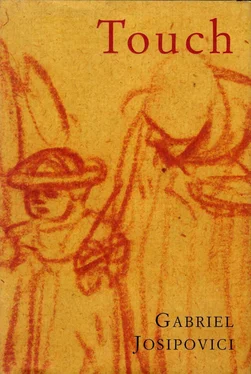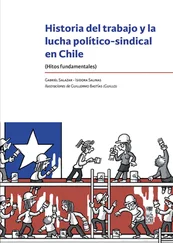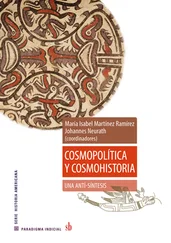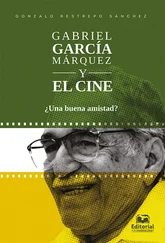Gabriel Josipovici - Touch
Здесь есть возможность читать онлайн «Gabriel Josipovici - Touch» весь текст электронной книги совершенно бесплатно (целиком полную версию без сокращений). В некоторых случаях можно слушать аудио, скачать через торрент в формате fb2 и присутствует краткое содержание. Год выпуска: 1996, ISBN: 1996, Издательство: Yale University Press, Жанр: Современная проза, на английском языке. Описание произведения, (предисловие) а так же отзывы посетителей доступны на портале библиотеки ЛибКат.
- Название:Touch
- Автор:
- Издательство:Yale University Press
- Жанр:
- Год:1996
- ISBN:0300066902
- Рейтинг книги:5 / 5. Голосов: 1
-
Избранное:Добавить в избранное
- Отзывы:
-
Ваша оценка:
- 100
- 1
- 2
- 3
- 4
- 5
Touch: краткое содержание, описание и аннотация
Предлагаем к чтению аннотацию, описание, краткое содержание или предисловие (зависит от того, что написал сам автор книги «Touch»). Если вы не нашли необходимую информацию о книге — напишите в комментариях, мы постараемся отыскать её.
Touch — читать онлайн бесплатно полную книгу (весь текст) целиком
Ниже представлен текст книги, разбитый по страницам. Система сохранения места последней прочитанной страницы, позволяет с удобством читать онлайн бесплатно книгу «Touch», без необходимости каждый раз заново искать на чём Вы остановились. Поставьте закладку, и сможете в любой момент перейти на страницу, на которой закончили чтение.
Интервал:
Закладка:
Thomas, like a number of recent scholars, is concerned to trace the uneasy cohabitation in such works of the scholarly and the prurient, and to alert us to the tension which, in eighteenth-century England at least, lay behind the use of the words ‘curio’, ‘curious’ and ‘curiosity’. For Dr Johnson, for example, in his Dictionary (1755), to be curious is to be ‘addicted to enquiry’, but in his Journey to the Western Isles (1775) he reproves a writer who failed to ascertain the precise breadth of Loch Ness for being ‘very incurious’. And this tension, Thomas shows with great erudition and sensitivity, is still there in the accounts (and no doubt the minds) of those first African explorers, John Barrow and Mungo Park who, at the turn of the nineteenth century, were still unclear whether their voyages were scientific, colonialist or driven simply by curiosity.
This was the time too, as we have seen, when the notion of genre first began to ring hollow, for genre depends ultimately on the sense that there is a place for everything and everything is in its place, that the world is ordered and art can reflect that order. It is no coincidence that the breakdown of genre, typified by Dr Johnson's criticism of Lycidas , should coincide with the rise of the novel, that genreless form which cannot make up its mind whether its ultimate appeal is to Truth or curiosity. Sterne plays with this (and with the reader) all the way through Tristram Shandy , notably when he orders the female reader back to the previous chapter and then stops to comment: ‘I have imposed this penance upon the lady, neither out of wantonness nor cruelty, but from the best of motives … — 'Tis to rebuke a vicious taste, which has crept into thousands besides herself, — of reading straight forwards, more in quest of the adventures than of the deep erudition and knowledge which a book of this cast, if read over as it should be, would infallibly impart with them … — But here comes my fair Lady. Have you read over again the chapter, Madam, as I desired you?’ (I.20).
In the wake of Krzystof Pomian's pioneering work on early Italian collectors and collections, many scholars have begun to explore the ways in which and the reasons for which national museums grew out of private and church collections, and to reveal the tensions that underlay them all between the claim to be advancing science, the pandering to curiosity and the growth of national pride. At first it was learned and wealthy individuals who collected. Humanist popes and Renaissance princes (often the same people) had started collecting classical statues in the fifteenth century. Others began to collect manuscripts and paintings. A number of Renaissance paintings ( Las Meninas being among the last and greatest) actually depict the owner in the midst of his pictures, which are hung on and stacked against the walls around him. But by the nineteenth century the great private collections had been democratised. In Paris the Louvre, the ancient palace of the kings of France, became the Musée Napoléon; in Madrid the royal collections moved into the Prado, the first modern building to house an art museum. The Altes Museum was opened in Berlin in 1830, followed by Munich (1836), London (1838), Dresden (1855), Amsterdam (1885), Vienna (1891) and Moscow (1912).
But of course by the nineteenth century the mania for collecting had passed from the learned and wealthy, from emperors and governments to every middle-class child. This was the time when children's encyclopedias began to be published (the first, adult encyclopedias date from the previous century), and when fossils, butterflies, shells, pressed flowers and anything else one could think of began to be collected by children with the encouragement of their parents. Even in Egypt, on the fringes of the western world, in the middle years of the present century, I found myself caught up in the last stirrings of this mania, which was encouraged by the English books and magazines I read: The Castle of Adventure, Swallows and Amazons, The Railway Children, Boy's Own Paper, The Eagle, World Sports . I seem to have spent my childhood, when I was not playing football or tennis or taking part in swimming and athletic competitions, sticking pictures into scrapbooks, putting objects into boxes and labelling them or arranging them in specially prepared trays. My most treasured possessions were my collection of prehistoric flints, picked up in the course of walks and bicycle rides into the desert just beyond the confines of the little town where I grew up, and a scrapbook I made of the 1952 Olympic Games, in which every result of every heat of every event was lovingly included.
I'm not sure about stamp-collecting and train-spotting, but, by and large, it seems to me that the collecting mania was a richly educative one for the children who succumbed to it. One was, in a way, making something of one's own, and one learned in the process about archaeology and botany and history and geography and countless other subjects. Unfortunately, like so many other childhood passions, this mania for collecting can take on rather more sinister connotations when it passes undiminished into adulthood. One particular collecting mania indulged in by adults in the second half of the twentieth century demonstrates this only too clearly.
16 Possessing Power
To possess a relic was to possess power. As Peter Brown shows, at its origins the cult of relics was carefully controlled precisely so as to maintain the aura of the relic and to lead the pilgrim to recognise that distance was an essential component praesentia . In this way the pilgrim would be led to place the relic within the context of a narrative at whose centre stood the death of the first martyr, Jesus Christ, the Son of God, who had died that mankind might be saved. By the time of the Reformation, as we can see from the many satires on relics and indulgences, on greedy clerics and gullible consumers, that sense of aura had all but vanished. A fragment of the true cross or a piece of saint's clothing could be thought as likely to protect you from death or disease as the magic girdle which Gawain so gratefully accepted. Yet the need to displace yourself and go to seek such relics still, to some extent, preserved the sense praesentia , and the evidence at the shrines of the wonders and cures associated with the relics still conveyed powerfully the sense that, even if no one else did, God still cared for the poor, the excluded and the sick. A couple of centuries on and we see, in Tradescant's collection, and in the German visitor's response to it, that ‘a small piece of wood from the cross of Christ’ has become simply an object of natural curiosity, like a flying squirrel or the hand of a mermaid. What seems to happen in what French historians have called ‘the history of everyday life’ is that when certain social practices and assumptions are discarded as false and fantastic the needs they fulfilled remain and, with nothing now to acculturate them, become a source of pain and anxiety and the generators of dangerous dreams and desires.
Nowhere is this more in evidence than in the repulsive trade in Nazi memorabilia which has gone on unabated since the end of the Second World War and the collapse of the Third Reich. Robert Harris, who dug deep into dais cesspit when researching for his book on the bizarre episode of the forged Hitler diaries, has come up with some startling figures (at least they startled me). ‘It has been estimated’, he writes, ‘that there are 50,000 collectors of Nazi memorabilia throughout the world, of whom most are Americans, involved in a business which is said to have an annual turnover of $50 million.’ In the United States a monthly newsletter, Der Gauleiter , keeps up to five thousand collectors and dealers informed of the latest trade shows and auctions. In Los Angeles one collector amuses himself in private by wearing Ribbentrop's overcoat. In Kansas City another serves drinks from Hitler's punch-bowl. In Chicago a family doctor has installed a concrete vault beneath his house, where he keeps a collection of Nazi weapons. In Arizona a used car salesman drives his family around in the Mercedes which Hitler gave to Eva Braun. In England, at his ancestral home, Longleat, the Marquess of Bath has gathered the largest collection of paintings by Hitler, worth, according to one estimate, ten million dollars. In the room with the paintings were to be seen as well ‘a life-size wax model of Hitler wearing a black leather overcoat and a swastika armband …, Himmler's spectacles …, the Commandant of Belsen's tablecloth’.
Читать дальшеИнтервал:
Закладка:
Похожие книги на «Touch»
Представляем Вашему вниманию похожие книги на «Touch» списком для выбора. Мы отобрали схожую по названию и смыслу литературу в надежде предоставить читателям больше вариантов отыскать новые, интересные, ещё непрочитанные произведения.
Обсуждение, отзывы о книге «Touch» и просто собственные мнения читателей. Оставьте ваши комментарии, напишите, что Вы думаете о произведении, его смысле или главных героях. Укажите что конкретно понравилось, а что нет, и почему Вы так считаете.












